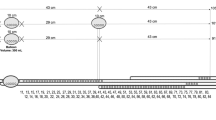Abstract
The maximal anal basal pressure (MABP) was measured with probes of 0.3, 1, 2 and 3 cm diameter in 21 subjects, 60 years old, without anal pathology. The components of MABP were analyzed by inducing a maximal internal sphincter (IS) relaxation, taking pressure measurements in the conscious state and during narcosis with curarization. In seven cases pressure measurements were done on isolated anorectum after abdominoperineal rectum amputation. MABP increases with probe diameter before as well as during anaesthesia with curarization. The contribution of the striated sphincter tonic activity is constant within the range of probe diameters used. At rest, i.e. when the 0. 3 cm diameter pressure recording probe is used, 30% of MABP is made up by striated sphincter tonic activity, 45% of it is due to nerve induced IS activity, 10% to purely myogenic IS activity and 15% can be attributed to the expansion of the haemorrhoidal plexuses. Although MABP is mainly based on active forces generated by the smooth and striated sphincter apparatus, the presence of the anal cushions is essential for perfect anal continence, as they have to fill the gap within the IS ring to hermetically close the anal canal. The global IS activity, contributing 50–60% of MABP at rest, can completely be inhibited by a maximal rectoanal inhibitory reflex. Stretching of passive elements starts at 1 cm anal distension, but steeply increases thereafter, accounting for 65% of the MABP at 3 cm anal distension. It is deduced that optimal stool diameter is about 2 cm.
Similar content being viewed by others
References
Kerremans R (1969) Morphological and physiological aspects of anal continence and defaecation. Editions Arscia SA, Brussels, p 263
Duthie H (1971) Anal continence. Gut 12:844–852
Kuypers J (1984) Faecal incontinence and the anorectal angle. Neth J Surg 36:20–23
Read N, Bartolo D, Read M (1984) Differences in anal function in patients with incontinence to solids and in patients with incontinence to liquids. Br J Surg 71:39–42
Bennett R, Duthie H (1964) The functional importance of the internal anal sphincter. Br J Surg 51:355–357
Floyd W, Walls E (1953) Electromyography of the sphincter ani externus in man. J Physiol 122: 599–609
Schuster M (1975) The riddle of the sphincters. Gastroenterology 69:249–262
Shepherd J (1972) The nerve supply of the internal anal sphincter. Aust NZ J Surg 42:50–52
Burleigh D, D'Mello A (1983) Neural and pharmacologic factors affecting motility of the internal anal sphincter. Gastroenterology 84:409–417
Frenckner B, Ihre T (1976) Influence of autonomic nerves on the internal sphincter in man. Gut 17:306–312
Frenckner B, von Euler C (1975) Influence of pudendal block on the function of the anal sphincters. Gut 16:482–489
Gibbons C, Trowbridge E, Bannister J, Read N (1986) Role of anal cushions in maintaining continence. Lancet 1:886–887
Gibbons C, Bannister J, Trowbridge E, Read N (1986) An analysis of anal sphincter pressure and anal compliance in normal subjects. Int J Colored Dis 1:231–237
Duthie H, Watts J (1965) Contribution of the external anal sphincter to the pressure zone in the anal canal. Gut 6:64–68
Schweiger M (1979) Method for determining individual contributions of voluntary and involuntary anal sphincters to resting tone. Dis Colon Rectum 22:415–416
Duthie H, Kwong N, Brown B (1970) Adaptability of the anal canal to distension (Abstract). Br J Surg 57:388
Wheatley I, Hardy K, Dent J (1977) Anal pressure studies in spinal patients. Gut 18:488–490
Meunier P, Mollard P (1977) Control of the internal anal sphincter. Manometric study with human subjects. Pflügers Arch 370:233–239
Baumgarten H (1967) Über die Verteilung von Catecholaminen im Darm des Menschen. Z Zellforsch 83:133–137
Baumgarten H, Holstein A, Stelzner F (1971) Differences in the innervation of the large intestine and internal anal sphincter in mammals and humans. Verhandlungen der Anatomischen Gesellschaft 66:43–47
Gutierrez J, Shah A (1975) Autonomic control of the internal anal sphincter in man. In: Vantrappen G (ed) 5th International Symposium of Gastrointestinal Motility (Belgium). Typoff Press, pp 363–373
Schiller L, Santa Ana C, Schmulen A, Hendler R, Harford W, Fordtran J (1982) Pathogenesis of faecal incontinence in diabetes mellitus. N Engl J Med 307:1666–1671
Neil M, Parks A, Swash M (1981) Physiological studies of the anal sphincter musculature in faecal incontinence and rectal prolapse. Br J Surg 68:531–536
Matheson D, Keighley M (1981) Manometric evaluation of rectal prolapse and faecal incontinence. Gut 22:126–129
Cortesini C, Pucciani F, Carassale G, Paparozzi C (1983) Anorectal physiology after anterior resection and pullthrough operation. Eur Surg Res 15:176–183
Jostarndt L, Thiede A, Lau G, Hamelmann H (1984) Die anorectale Kontinenz nach manueller und maschineller Anastomosennaht. Chirurg 55:385–390
Bartram C (1988) In: Finlay I. Symposium on proctography. Int J colored Dis 3:67–89
Womack N (1988) Symposium on proctography (Moderator: Finlay IG). Int J Colored Dis 3:67–89
Author information
Authors and Affiliations
Rights and permissions
About this article
Cite this article
Lestar, B., Penninckx, F. & Kerremans, R. The composition of anal basal pressure. Int J Colorect Dis 4, 118–122 (1989). https://doi.org/10.1007/BF01646870
Accepted:
Issue Date:
DOI: https://doi.org/10.1007/BF01646870




